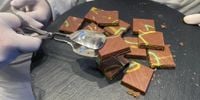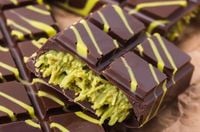The Dubai chocolate, a chocolate bar with pistachio cream, kataifi pastry, and tahina, has taken the world by storm, igniting a global craze that has significantly impacted the price and availability of pistachios. Originating in the United Arab Emirates, this innovative treat first surfaced in 2022, created by Fix Chocolatier, founded by Sarah Hamouda and her husband Yezen Alani. What began as a personal craving during Hamouda's pregnancy has transformed into a viral sensation, largely thanks to a TikTok video that catapulted it into the spotlight.
In December 2023, food influencer Maria Vehera posted a TikTok video featuring Fix Chocolatier's "Can’t Get Knafeh Of It" bar, which quickly amassed millions of views. This surge in popularity led to a dramatic increase in orders, and the product was soon dubbed the "Dubai chocolate" by the public. The combination of traditional Middle Eastern flavors with a contemporary twist captured the imagination of consumers worldwide, leading to a notable spike in demand.
According to Giles Hacking of CG Hacking, the rising demand for pistachios, spurred by the Dubai chocolate craze, has resulted in a staggering 35 percent increase in pistachio prices globally. "At the moment, the market is practically at its limit," Hacking stated, highlighting the strain on suppliers as they struggle to keep up with the newfound interest in this once niche ingredient.
Initially, Fix Chocolatier operated without a physical store or international distribution, relying on local influencers to promote their product. However, the viral success of the Dubai chocolate quickly changed that. Lindt, a major player in the chocolate industry, was among the first to recognize the trend outside the UAE. Margherita, a staff member at a Lindt store in Aachen, Germany, recalled a customer asking for the Dubai chocolate after returning from vacation, unaware of its sudden rise to fame. "I had no idea what it was," she admitted, noting that her colleague explained the TikTok trend that had sparked so many inquiries.
Typically, introducing a new product at Lindt involves extensive market research and testing, taking months or even years. However, the urgency surrounding the Dubai chocolate prompted a swift response. In November 2024, Lindt launched its version, producing 1,000 handmade bars for select boutiques in Germany. On launch day, customers lined up as early as 2 AM to get their hands on the limited-edition product. Adalbert Lechner, CEO of Lindt & Sprüngli, noted that the demand was so intense that some bars were resold on eBay for hundreds of euros. "People were so interested in this product that they were willing to pay a premium," he remarked.
By December 2024, Lindt expanded its sales to other European countries and the United States, following the overwhelming response. The chocolate's popularity prompted the company to announce that the Dubai chocolate would become a permanent addition to its product lineup, with plans to modify the formula for mass production. "It has become one of our strongest products ever," Lechner said proudly.
Other brands quickly jumped on the bandwagon, eager to capitalize on the Dubai chocolate phenomenon. In Italy, Esselunga launched its version under the brand 'Delica Dore' in 2025, while Lidl introduced a 'Dubai Style' line featuring a chocolate bar priced at just 4 euros, marketed under the J.D. Gross brand. Even artisanal producers got in on the action; Milanese pastry chef Ernst Knam, known as the "King of Chocolate," created his own interpretation of the Dubai chocolate, incorporating Sicilian pistachios, kataifi, sesame cream, and dark chocolate with Maldon salt.
The meteoric rise of the Dubai chocolate can be attributed to several factors, as noted by semiologist Gianfranco Marrone, an expert in food communication and the phenomenon of "foodporn." First, the cultural fusion of traditional chocolate with Middle Eastern flavors resonates with consumers seeking novel experiences. Second, the allure of luxury during times of crisis amplifies interest in high-end products. Finally, the artificial scarcity created by limited availability has driven demand, a strategy previously employed by brands like Nutella and Mulino Bianco to heighten consumer desire.
As the Dubai chocolate continues to gain traction, the impact on the pistachio market is undeniable. The increasing demand has led to a significant rise in prices, with the cost of pistachios in the United States surging by 26 percent over the past two years, from $7.65 to $10.30 per ounce. This trend correlates with poor harvests in California, one of the world's leading pistachio producers, which has struggled to keep up with the soaring demand. Imports have risen by 15 percent, yet they remain insufficient to meet the internal needs of the U.S. market.
Interestingly, the situation is quite the opposite in Iran, which has ramped up its pistachio exports to the UAE, where Fix Dessert Chocolatier is based. In the last year alone, Iran exported 40 percent more pistachios to the UAE, indicating that the Dubai chocolate phenomenon may have broader implications for global trade and agricultural practices.
The Dubai chocolate craze is not just a fleeting trend; it represents a significant shift in consumer preferences and the global chocolate market. As brands continue to innovate and adapt to this new landscape, the intersection of social media influence and culinary creativity will likely shape the future of food products. Whether or not the Dubai chocolate maintains its status remains to be seen, but for now, it has undeniably left an indelible mark on both consumers and producers alike.


